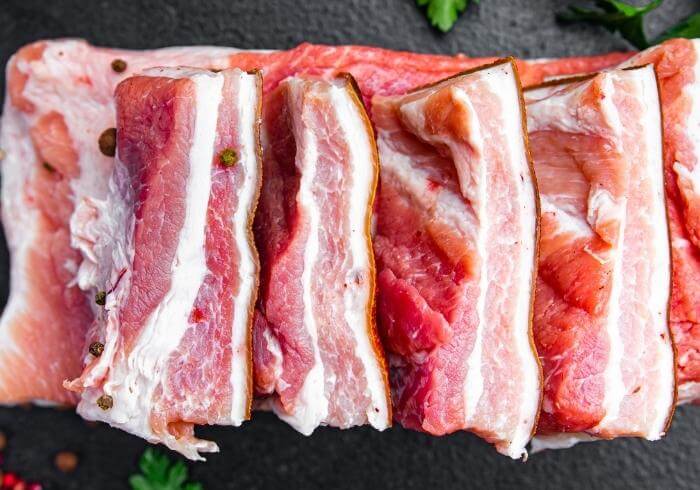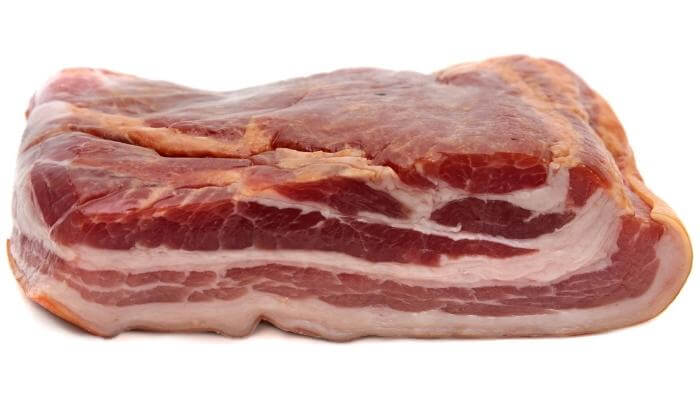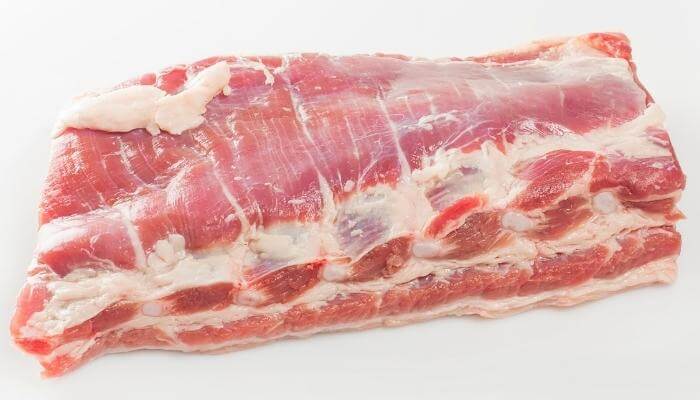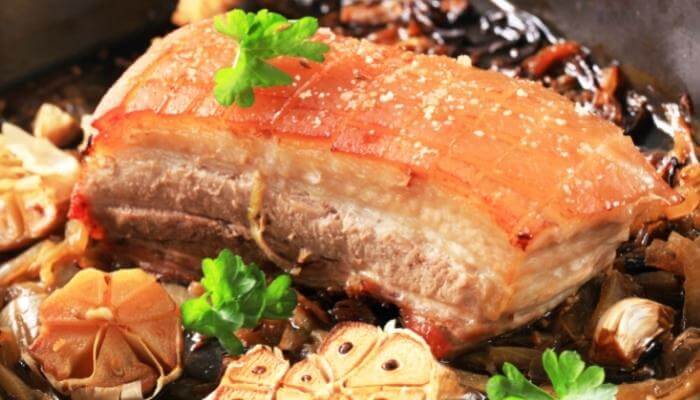Pork belly and bacon have a lot more in common than their differences. Historically, they both started as the same part of the pig, even though bacon has now expanded to include many alternative parts. But not all pork belly is bacon, and not all bacon is pork belly.
In this guide, we’ll break down the similarities and difference between bacon and pork belly. We’ll take you through the process of turning pork belly into bacon and touch on the do’s and don’ts of preparing and serving both.

What Is Bacon And Where Does It Come From?

When we talk about bacon, we’re usually talking about cured meat from the belly area of the pig. The bacon umbrella has become so popular that it has spread to cover other pork parts and even parts from other animals.
Besides the highly coveted abdominal area, you can find bacon made from pork shoulder, loin, cheeks, and back. You can also find turkey bacon made from dark and light turkey meat ground and pressed into the familiar iconic bacon shape.
Then there are bacon brands made from chicken and lamb meat, and you can even find vegetarian bacon made from tofu, coconut, or seitan.
What really makes bacon is the slow curing, drying, and smoking process that infuses the strips with their decadent savory sweetness and makes most of us fall head over heels.
In the USA, the most popular bacon is taken from the fleshy underbelly or side of the pig. To industry insiders and hardcore bacon bros, this is known as side bacon or streaky pork bacon.

This cut naturally features that internationally recognizable layered look that immediately pops into your head when you think of bacon. It starts with a strip of rind on top, a layer of fat just beneath, and then strips of muscle under that running parallel to the skin.
A good rule of thumb to remember is that, while the most popular bacon does come from pork belly, not all bacon comes from pork belly, and not all pork belly is made into bacon.
Bacon taken from different parts of the pig has different names. Here are a few of the most interesting ones:
- Cottage bacon is cut from the shoulder primal
- Jowl bacon comes from the hollow of the pork cheek
- Back bacon comes from the loin primal and is leaner than most other pork bacon
- Streaky or side bacon, from the belly, is generally the thickest kind of bacon
- Slab bacon also comes from the side primal but is made from the least expensive parts of it
Wherever the meat comes from, the curing process is more or less the same. In general terms, you cure meat by saturating it with salt to suck out the moisture. This makes it inhospitable terrain for pathogens.
Bacon-specific curing usually takes about a week. Once the moisture level is low enough, the salt and nitrites used to cure it are disgarded, and the meat is left to dry for about a day.
Finally, the low-moisture cut is enclosed with a smoldering wood furnace, which fills it with that smoky finishing touch that many of us find irresistible.
This convoluted and time-intensive process is why bacon generally costs more than regular pork belly.

Despite its thorough curing ordeal, you should still cook bacon before you eat it. The good news here is that, as opposed to pork belly, it’s hard to cook bacon wrong and you can save the grease for other flavored cooking.
Most people like their bacon crisp, which takes just a few minutes in a sizzling frying pan. If you’re a beginner in the kitchen or in a bit of a hurry, bacon is quicker and easier to prepare and consume than pork belly.
Bacon is famous for being the Swiss army knife of food. You can use it as the centerpiece of the meal or as a supporting actor to give a crunchy twist to a sandwich, salad, soup, pizza, or burger. The salty meat even shines counterintuitively in desserts alongside sweet chocolate or vanilla.
Bacon works best if you want to:
- Crisp up for pasta, salad, sandwich, or side dish
- Give your breakfast an extra kick
- Wrap up something moist and soft like shrimp, avocado slices, or pineapple chunks
- Add a salty twist to a sweet treat
SEE ALSO: How To Tell If Bacon Is Bad
What Is Pork Belly And Where Does It Come From?

Pork belly is a thick, boneless meat slab cut from the pig’s underside.
Just like you’d imagine when you think of a belly, the meat comes swathed in thick layers of juicy fat to make an extra-rich cut. The pork skin is usually included in the slab, although you can also buy pork belly with no rind.
The first thing that sets pork belly apart from bacon is the curing process we talked about above. Pork belly comes straight from the pig, uncured and unprocessed. It has no additives, chemicals, or unidentified synthetic objects.
If you prefer your pork as close to nature as possible, you’ll like the raw belly better than the bacon’s barrage of sodium and nitrites. If you’re more concerned about the fats you eat, pork belly does tend to have a higher fat content than bacon.
The second thing that separates these two delicacies is how you prepare them. Where bacon is best served crisp, pork belly cooked properly should fall apart in your mouth with only a touch of crunch from the rind. Overcooking pork belly meat will make it rubbery and dry rather than deliciously crunchy.
If you’re still learning the ropes of cooking, pork belly can be tough. Its finicky cooking behavior may be why such a tasty cut is so affordable compared to other tender parts like the loin.
Before its cooking secrets were widely available, pork belly used to be used almost exclusively for sausages. Even now that the cat’s out of the bag, the difficulty of cooking it right seems to have kept its price low.

Pork belly also takes a while to prepare. The downside of its richness is that it takes a low, slow flame to fully render all that fat. You can roast, grill, braise, fry or bake it, as long as you do it slowly.
Less versatile than bacon, pork belly is generally used as the savory centerpiece of the meal. It also pairs well with noodles or is stir-fried with vegetables and spices.
Pork belly works best for:
- Slow-roasting
- Deep-frying
- Braising over a low flame
- Simmering in a stew
- Flash-grilling with a vegetable kaleidoscope
Is Pork Belly the Same As Bacon?
While they can certainly start out the same, pork belly and bacon go through wildly different hero’s journeys before making it into your mouth.
Bacon’s trek involves an arduous, dry curing process of salt and smoke followed by a quick fry for a crunchy, salty result. Pork belly’s journey usually takes it through a slow, moist cooking process, from which it emerges a tender and succulent centerpiece of a hearty meal.











